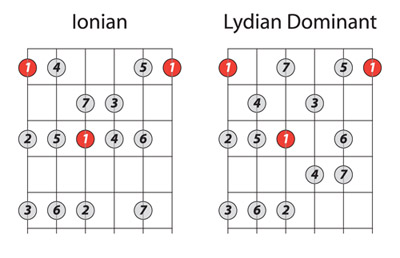Anatomy of a Mode: Lydian Dominant
The Lydian Dominant Mode
Lets take a look at one of my favorites, the Lydian Dominant, and see what makes it tick…

Intervals
The Lydian Dominant is one of the modes that are derived from the Melodic Minor Scale. The notes in the C Lydian Dominant are as follows:
C D E F# G A Bb C
Compare this to the C major scale, or C Ionian mode:
C D E F G A B C
If we use the numbers, with C Ionian being 1 2 3 4 5 6 7 1, then you’ll notice the Lydian Dominant has a sharp (#) 4 and a flat (b) 7. There are a few ways this affects what can be played:
- the melodies that come out of it will sound different compared to those that can be played in the more common natural modes
- The extended arpeggio will give us a bit of an unusual chord — a dominant 7 #11 chord
- The notes in it can tend to lead into unexpected chords (when it’s time to change chords)
Ok, to understand a little better what I’m talking about here, maybe we should take a minute to talk about musical colors first..
The Colors of Music
Ever notice how children’s toys are in bright primary colors, red blue, yellow, some green, maybe purple? When we’re young we can identify the big contrasts between colors like blue and yellow, but the more subtle alterations of color aren’t so easy to pick up. There are a myriad of color tones that can be made by mixing the simple colors, and when touches oof the most opposite colors are employed the most complex tones can be created. Music works much the same way. The very harmonious basic combinations of C and c (1 and the higher 1 in the C major scale, for example) or C and G are really easy to deal with. A combination like C and G is also so generic it can be part of a major or a minor chord.
Take a 1 and 5 and add the 3 into it, and we now have the basic triad notes — a simple major scale, if the Ionian is used. The 3 is what changes to determine whether a mode is major or minor. The 1, 3, and 5 played in any combination or from any octave will create voicings of a major chord. If the mode contains a 1, b3 and 5 then the chord formed will be minor.
Add the 7 into the mix, and we’ve got twice as many possibilites. 1 3 5 and 7 form a major 7th arpeggio (an arpeggio is just the chord tones played one at a time). 135 and b7 form a dominant 7th arpeggio.
Extended Arpeggios
As I said earlier, the Lydian Dominant gives us a dominant7 #11 chord. As you can see, the notes in the modes go from 1 to 7, and then 1 again. From C to c (the next higher “c”) the distance is an octave, symbol 8ve. So, 1 = 8. By this reasoning 2 = 9, 4 = 11, and 6 = 13. When someone says “play a C major 9 chord” they’re really saying “play the 1 3 5 7 and 9 (or 1 3 5 7 2) of an Ionian mode. In this way the arpeggio can be extended all the way to a 13th chord — 1 3 5 7 9 11 13 or 1 3 5 7 2 4 6 — which is actually 1 2 3 4 5 6 7!
Now, remember what i said about colors? Red and green are complete opposites. Mix a little red with a bunch of green and you’ll get a greyed down green. the more red into that green, the greyer it’ll get. Well, a major 3 and a b7 are complete opposites — a tritone apart. They’d be at 12 o’clock and 6 o’clock on the circle of fifths (more on that in coming pages). This creates tension — a little musical grey, if you will. It makes the chord sound restless, as if it’s looking for a resolution.
In a dominant 7 #11 chord the same kind of tension happens when we play the 1 and the #11 (#4) together. We’re adding even more red to the green, so to speak. The greyer, or more complex, a chord becomes, the more directions it can lead in. And it can begin to sound like other chords, or be substituted with another chord. In fact, you could sneak a song into a whole different key in mid-song. The listener will hear the tension and it will translate to drama, emotion, dynamics.
Use the diagrams for playing the Ionian and Lydian Dominant Modes. Play through each of them from bottom to top, and then try switching back and forth between them using the following melodic patterns, to get an idea of how they sound alike, and how they sound different.
1 3 5 3 1
1 3 4 5 4 3 1
1 3 4 5 7 3 1
1 3 5 4 7 4 5 3 1